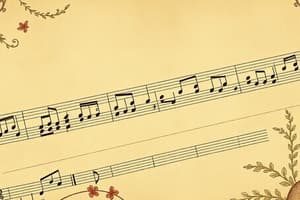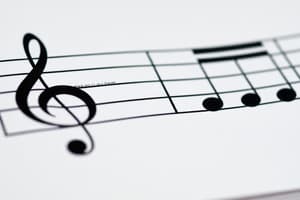Podcast
Questions and Answers
Where is the treble clef commonly seen on the staff?
Where is the treble clef commonly seen on the staff?
- At the end of the staff
- On the first ledger line below the staff
- After the first space at the beginning of the top line (correct)
- On the third space from the top
How many lines are there in a standard staff?
How many lines are there in a standard staff?
- Five lines (correct)
- Four lines
- Seven lines
- Six lines
Which type of notes represent higher pitches on the staff?
Which type of notes represent higher pitches on the staff?
- Notes on higher lines (correct)
- Notes on ledger lines
- Notes on spaces
- Notes on lower lines
Which note has the largest time unit value?
Which note has the largest time unit value?
In Western notation, which clef indicates the highest pitch range?
In Western notation, which clef indicates the highest pitch range?
How many ledger lines are there above or below a standard staff?
How many ledger lines are there above or below a standard staff?
What does the word 'treble' originate from?
What does the word 'treble' originate from?
On the treble clef staff, what note is represented by the second line from the bottom?
On the treble clef staff, what note is represented by the second line from the bottom?
Where does 'Middle C' fall on the treble clef staff?
Where does 'Middle C' fall on the treble clef staff?
Which note is represented by the fifth line on the treble clef staff?
Which note is represented by the fifth line on the treble clef staff?
Why is practice important in learning to interpret notes on a staff?
Why is practice important in learning to interpret notes on a staff?
Study Notes
Musical Notes on the Staff and Treble Clef
The music notation system we use today is based on a set of universal symbols known as musical notes. These notes represent different pitches and durations that musicians can play or sing. Understanding how they fit together on a staff is essential knowledge for any musician. Here's what you need to know about musical notes on the staff and the most common clef used in Western notation.
Musical Notation Basics
A staff is a series of five horizontal lines with four spaces between them. This staff represents one octave of music. Standard staves are either four ledger lines above or below the line where your musical piece begins. Each line on the staff corresponds to a specific pitch; higher pitches are represented by higher lines on the staff, while lower pitches are represented by lower lines.
Each note has a duration, which tells you how long it lasts. There are several types of notes and rests, each having their own appearance and meaning within a measure. Quarters are the standard length for individual tones, semibreves are the largest time unit, and mini-rhythm dots are the smallest division of rhythm, falling in between two sixteenth notes.
Treble Clef
The treble clef, also called the G clef because its symbol resembles a G note, is commonly seen at the beginning of a staff and indicates that the highest pitch range will be written there. It is placed after the first space at the beginning of the top line of the staff. The word 'treble' comes from the Latin word 'trabella', which means 'bridle', referring to the sound produced when horses neigh.
In the treble clef, each line represents a particular note. From bottom to top, these notes are E, G, B, D, and F. So when you see a note on the second line of the staff, for example, you know it must be a G note. Middle C falls on the third line, with A being on the fourth line and G again on the fifth line.
Practice Makes Perfect
Learning to interpret notes on a staff takes practice. As you become more familiar with reading music, identifying the correct pitches using the staff becomes easier and faster. By understanding the note names on the staff and getting comfortable with the treble clef, you'll be well on your way to mastering this critical part of music theory.
Studying That Suits You
Use AI to generate personalized quizzes and flashcards to suit your learning preferences.
Description
Learn about the basics of musical notes and how they are placed on a staff in Western notation. Explore the significance of the treble clef and how it indicates the pitch range of music written on the staff. Practice interpreting note names and understanding the relationship between pitches and staff lines.




